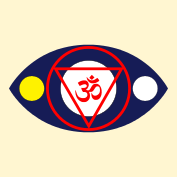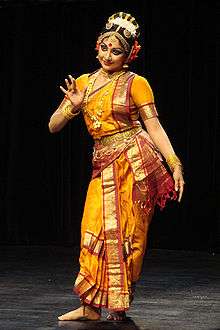Bindi (decoration)
A bindi (Hindi: बिंदी, from Sanskrit बिन्दु bindú, meaning "point, drop, dot or small particle") is a coloured dot worn on the center of the forehead, originally by Hindus and Jains from the Indian subcontinent. The word bindu dates back to the hymn of creation known as Nasadiya Sukta in the Rigveda.[1] Bindu is considered the point at which creation begins and may become unity. It is also described as "the sacred symbol of the cosmos in its unmanifested state".[2][3]
A bindi is a bright dot of some colour applied in the centre of the forehead close to the eyebrows worn in the Indian subcontinent (particularly amongst Hindus in India, Pakistan, Bangladesh, Nepal, Bhutan and Sri Lanka)[2] and Southeast Asia among Balinese, Javanese, Malaysian, Singaporean and Burmese Hindus. A similar marking is also worn by babies and children in China and, as in the Indian subcontinent and Southeast Asia, represents the opening of the third eye.[4] Bindi in Hinduism, Buddhism, and Jainism is associated with ajna chakra, and Bindu[5] is known as the third eye chakra. Bindu is the point or dot around which the mandala is created, representing the universe.[3][6] The bindi has a historical and cultural presence in the region of Greater India.[7][8]
Religious significance
Traditionally, the area between the eyebrows (where the bindi is placed) is said to be the sixth chakra, ajna, the seat of "concealed wisdom". The bindi is said to retain energy and strengthen concentration.[9] The bindi also represents the third eye.[10] The Nasadiya Sukta of the Rig Veda, the earliest known Sanskrit text, mentions the word Bindu.[1]
The Ajna is symbolised by a sacred lotus with two petals, and corresponds to the colours violet, indigo or deep blue, though it is traditionally described as white. It is at this point that the two sides Nadi Ida (yoga) and Pingala are said to terminate and merge with the central channel Sushumna, signifying the end of duality, the characteristic of being dual (e.g. light and dark, or male and female). The seed syllable for this chakra is the syllable OM, and the presiding deity is Ardhanarishvara, who is a half male, half female Shiva/Shakti. The Shakti goddess of Ajna is called Hakini. In metaphysics, Bindu is considered the dot or point at which creation begins and may become unity. It is also described as "the sacred symbol of the cosmos in its unmanifested state".[2][3] Bindu is the point around which the mandala is created, representing the universe.[6] Ajna (along with Bindu), is known as the third eye chakra and is linked to the pineal gland which may inform a model of its envisioning. The pineal gland is a light sensitive gland that produces the hormone melatonin which regulates sleep and waking up, and is also postulated to be the production site of the psychedelic dimethyltryptamine, the only known hallucinogen endogenous to the human body. Ajna's key issues involve balancing the higher and lower selves and trusting inner guidance. Ajna's inner aspect relates to the access of intuition. Mentally, Ajna deals with visual consciousness. Emotionally, Ajna deals with clarity on an intuitive level.[5]
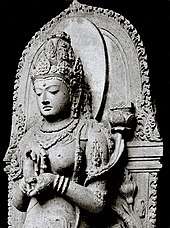
In Hinduism, Buddhism, and Jainism, bindi is associated with Ajna Chakra and Bindu.[5] Divinities in these religions are typically depicted with Bhrumadhya Bindu, in meditative pose with their eyes nearly closed show the gaze focused between eyebrows, other spot being the tip of the nose—Naasikagra. The very spot between the eyebrows known as Bhrumadhya is where one focuses his/her sight, so that it helps concentration.[6] In South Asia, bindi is worn by women of all religious dispositions and is not restricted to religion or region. However, the Islamic Research Foundation, located in India, says "wearing a bindi or mangalsutra is a sign of Hindu women. The traditional bindi still represents and preserves the symbolic significance that is integrated into Indian mythology in many parts of India."
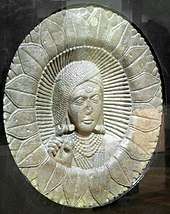
The red bindi has multiple meanings:
- One simple interpretation is that it is a cosmetic mark used to enhance beauty.
- Archaeology has yielded clay female figurines from the Indus Valley with red pigment on the forehead and hair parting. It is unclear whether this held any religious or cultural significance.[11]
- In Hinduism, the color red represents honor, love, and prosperity, hence it was worn to symbolise these aspects. [12]
- In meditation, the point between the eyebrows (Bhrumadhya) is where one focuses his/her sight, to help concentration. Most images of Hindu, Jain or Buddhist divinities in meditative poses with their eyes nearly closed show the gaze focused between the eyebrows (another spot being the tip of the nose—naasikagra).
- Swami Muktananda writes that "auspicious Kumkum or sandalwood paste is applied (between the eyebrows) out of respect for the inner Guru. It is the Guru's seat. There is a chakra (centre of spiritual energy within the human body) here called Ajna (Aadnyaa) chakra, meaning 'Command centre'. Here is received the Guru's command to go higher in Sadhana (spiritual practice) to the 'Sahasraar' (seventh and final chakra) which leads to Self-realisation. The flame seen at the eyebrow is called 'Guru Jyoti'."[13]
- The encyclopaedic Dictionary of Yoga reports that this 'Ajna Chakra' is also called the 'Third eye'. This centre is connected with the sacred syllable 'Om' and presiding, is 'Parashiva'. On activating this centre, the aspirant overcomes 'Ahamkar' (the ego or sense of individuality), the last stop on the path of spirituality.[14]
Traditional application method

A traditional bindi is red or maroon in colour. A pinch of vermilion powder is applied with a ring-finger to make a dot. A small annular disc aids application for beginners. First, they apply a sticky wax paste through the empty centre of the disc. This is then covered with kumkum or vermilion and then the disc is removed to get a round bindi. Various materials such as lac, sandal, 'aguru', mica, 'kasturi', kumkum (made of red turmeric) and sindoor colour the dot. Saffron ground together with 'kusumba' flower can also work.[15] Traditionally they are green in colour with a red dot in the middle.[16] The bindi is no longer restricted in colour or shape.[17][18]
Historically, the ornamental bindi spangle consists of a small piece of lac over which is smeared vermilion, while above it a piece of mica or thin glass is fixed for ornament. Women wore large spangles set in gold with a border of jewels if they could afford it. The bindi was made and sold by lac workers known as Lakhera.[19] In Hinduism, it's part of the Suhāg or lucky trousseau at marriages and is affixed to the girl's forehead on her wedding and thereafter always worn.[18] Unmarried girls optionally wore small ornamental spangles on their foreheads. A widow was not allowed to wear bindi or any ornamentation associated with married women.[18] In modern times, self-adhesive bindis are available in various materials, usually made of felt or thin metal and adhesive on the other side. These are simple to apply, disposable substitutes for older lac tikli bindis. Sticker bindis come in many colours, designs, materials, and sizes.
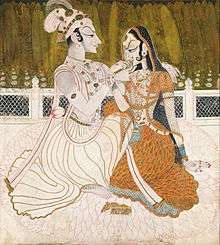
There are different regional variations of the bindi. In Maharashtra a large crescent moon shaped bindi is worn with a smaller black dot underneath or above, associated with Chandrabindu and Bindu chakra represented by crescent moon, they are commonly known as Chandrakor in this region, outside Maharashtra they are popularly known as Marathi bindi. In Bengal region a large round red bindi is worn, brides in this region are often decorated with Alpana design on forehead and cheeks, along with bindi. In southern India a smaller red bindi is worn with a white tilak at the bottom, another common type is a red tilak shaped bindi. In Rajasthan the bindi is often worn round, long tilak shaped bindi are also common, as well as the crescent moon on some occasions. Decorative bindis have become popular among women in South Asia, regardless of religious background. Bindis are a staple and symbolic for women in the Indian subcontinent.[20]
In addition to the bindi, in India, a vermilion mark in the parting of the hair just above the forehead is worn by married women as commitment to long-life and well-being of their husbands. During all Hindu marriage ceremonies, the groom applies sindoor in the part in the bride's hair.[21]
Apart from their cosmetic use, bindis have found a modern medical application in India. Iodine patch bindis have often been used among women in north-west Maharashtra to battle iodine deficiency.[22]
Related customs in other Asian regions
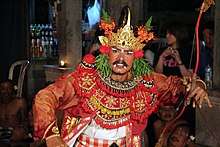
In Southeast Asia, bindis are worn by Balinese and Javanese Hindus of Indonesia. Historically, it was worn by many Indianized kingdoms in Southeast Asia. Bindis are also decorated on wedding brides and grooms of Java and other parts of Indonesia, even worn by non-Hindus. It is worn for cultural purposes because Indonesia was once ruled by Indianized Hindu kingdoms, thus the culture still preserves until today. Bindis in Indonesia are usually white, rather than red as in India.
Modern use

Bindis are popular outside the Indian subcontinent and Southeast Asia as well. They are sometimes worn purely for decorative purpose or style statement without any religious or cultural affiliation.[24] Decorative and ornamental bindis were introduced to other parts of the world by immigrants from the Indian subcontinent.[25] International celebrities such as Gwen Stefani, Julia Roberts,[26] Madonna,[27] Selena Gomez and many others have been seen wearing bindis. The appropriateness of such uses has been disputed. Reacting to Gomez wearing a bindi while singing her song "Come and Get It", Hindu leader Rajan Zed said that the bindi has religious significance and should not be used as a fashion accessory,[28] but Indian actress Priyanka Chopra praised Gomez's choice as "an embrace of Indian culture".[29]
Alternative terms
A bindi can be called:[30]
- Bhottu or Pottu in Tamil
- Phot or Phut (literally meaning a small pressing mark) in Assamese
- Tip (literally meaning "a pressing") in Bengali
- Tikuli (literally meaning "a small tika") in Madhyadeshi areas
- Chandlo in Gujarati meaning moon shape
- Tilaka in Hindi
- Tika in Nepali
- Kunkuma or Bottu or Tilaka in Kannada
- Tilakaya in Sinhala
- Tikli in Konkani
- Kunkoo कुंकू or Tikali टिकली in Marathi
- Tikili in Odia
- Bindi in Punjabi meaning long red mark
- Pottu or Kunkumam or Netri or Tilakam' in Tamil and Malayalam
- Bottu or Tilakam in Telugu
- Bottu in Kannada
- Alpana are the small decorative design over the eyebrows and cheeks used in marriage or festivals
- "Tikli" in Maithili
Images
_Attended_by_Sita_Tara_(White_Tara)_and_Bhrikuti_LACMA_M.84.32.1a-d.jpg) Shyama Tara attended by Sita Tara and Bhrikuti. India. ca. 8th century
Shyama Tara attended by Sita Tara and Bhrikuti. India. ca. 8th century Kalpasutra Manuscript, folio dated c.1375-1400. Miniature showing the birth of Mahavira (Vardhamana)
Kalpasutra Manuscript, folio dated c.1375-1400. Miniature showing the birth of Mahavira (Vardhamana) Kalpasutra Manuscript folio dated 1472. recto image of Trishala's grief
Kalpasutra Manuscript folio dated 1472. recto image of Trishala's grief Goddess Lalita flanked by Gaṇeśa and Kārttikeya, Pala Dynasty
Goddess Lalita flanked by Gaṇeśa and Kārttikeya, Pala Dynasty%2C_Kishangarh%2C_ca._1750%2C_National_Museum_New_Delhi.jpg) Courtesan Bani Thani as Radha with ornamental bindi spangle and maang tikka, ca. 1750
Courtesan Bani Thani as Radha with ornamental bindi spangle and maang tikka, ca. 1750 Lady with a bindi holding a wine cup and rose, ca. 1701
Lady with a bindi holding a wine cup and rose, ca. 1701 Bride with decorated forehead
Bride with decorated forehead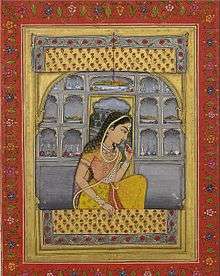 Idealized portrait of Princess Padmavati with maang tikka, ca. 1701
Idealized portrait of Princess Padmavati with maang tikka, ca. 1701
 Hindu bride with decorated bindi
Hindu bride with decorated bindi Hindu bride wearing Bindi and Groom with Tilaka
Hindu bride wearing Bindi and Groom with Tilaka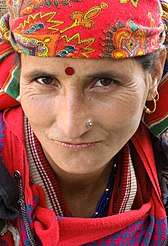 Himachali Hindu woman wearing a bindi
Himachali Hindu woman wearing a bindi- Modern stick-on bindi
 Bindi are often used as decoration or as a style statement.
Bindi are often used as decoration or as a style statement.
See also
References
- "nasadiya-suktha-and-purusha-suktha".
- Khanna 1979: p. 171
- Swami Ranganathananda (1991). Human Being in Depth: A Scientific Approach to Religion. SUNY Press. p. 21. ISBN 0791406792.
- Xiaoou, Yu (10 September 2014). "Guidelines for school entrance in ancient China". ChinaCulture.org. Retrieved 16 February 2018.
- Mercier (2007). p. 267.
- Shakya, pp. 82–83
- Southeast Asia: A Historical Encyclopedia, from Angkor Wat to East Timor, by Keat Gin Ooi p. 642
- Hindu-Buddhist Architecture in Southeast Asia by Daigorō Chihara p. 226
- Das, Subhamoy. "Bindi: The Great Indian Forehead Art". Retrieved 16 February 2009.
- "Couples Fuel India's Vibrant Art Scene". The New York Times. 13 October 2011. Retrieved 20 October 2011.
- M. Kenoyer, Jonathan (1998). Ancient Cities of the Indus Valley Civilization (1st ed.). Oxford University Press. p. 186. ISBN 0195779401.
- Pintchman, Tracy (2007). Women's Lives, Women's Rituals in the Hindu Tradition. Oxford. pp. 90–97. ISBN 0195177061.
- From Finite to Infinite, by Swami Muktananda, SYDA Foundation, S. Fallsburg, New York, 1989, pp. 88–89
- Encyclopedic Dictionary of Yoga, by Georg Fuerstein, Paragon House Publishers, New York, 1990, p. 15
- "Bindi: The Great Indian Forehead Art". About.com. Retrieved 9 January 2012.
- Bahadur, Om Lata (1996). The book of Hindu festivals and ceremonies (3rd ed.). New Delhi: UBS Publishers Distributors ltd. p. 168. ISBN 81-86112-23-5.
- Khadi and Village Industries Commission, Government of India
- Parvesh Handa, "Home Beauty Clinic", Pustak Mahal, ISBN 81-223-0099-5
- https://www.gutenberg.org/files/20668/20668-h/20668-h.htm
- Priyabala Shah (April 1986) "Tilaka: Hindu marks on the forehead", p.88
- Gwynne, Paul (2009). World Religions in Practice: A Comparative Introduction. Maiden, MA: Blackwell Publishing.
- Dhar, Shobha (11 April 2015). "Iodine bindis for tribal women to fight deficiency". TNN. The Times of India. Retrieved 25 July 2015.
- "Svami Sadananda Dasa: Disciple of Bhaktisiddhanta Sarasvati and Guru of Vamandas (Walther Eidlitz)". sadananda.com.
- Khu phố Little India ở Artesia, Nguoi Viet Online, 11 November 2011, Retrieved 22 November 2011
- Juventud organiza un mercadillo solidario a beneficio de la Fundación Vicente Ferrer, elperiodic.com, 17 November 2011. Retrieved 22 November 2011
- "'Pretty Woman' in temple upset". BBC News. 23 September 2009. Retrieved 26 April 2010.
- "Try a bindi now with Western wear". Punjab Newsline. 6 October 2011. Archived from the original on 30 March 2012. Retrieved 20 October 2011.
- Sieczkowski, Cavan (16 April 2013). "Selena Gomez Bindi: Hindu Leaders Demand Apology For MTV Movie Awards Costume". Huffington Post. Retrieved 25 September 2015.
- DelliCarpini Jr., Gregory (22 May 2013). "Selena Gomez's Bindi Styling: Offensive? Bollywood Star Priyanka Chopra Talks About the Star's Usage". Billboard. Retrieved 25 September 2015.
- "Dazzling bindis". MSN India. 10 October 2011. Archived from the original on 12 October 2011. Retrieved 20 October 2011.
External links
| Wikimedia Commons has media related to Bindi. |
- Bindi design as hobby
- Bindi and its significance
- "History & Significance of Bindis". Retrieved 30 September 2013.
- "Bindis: Everything You Need to Know". Archived from the original on 5 April 2014. Retrieved 30 September 2013.

